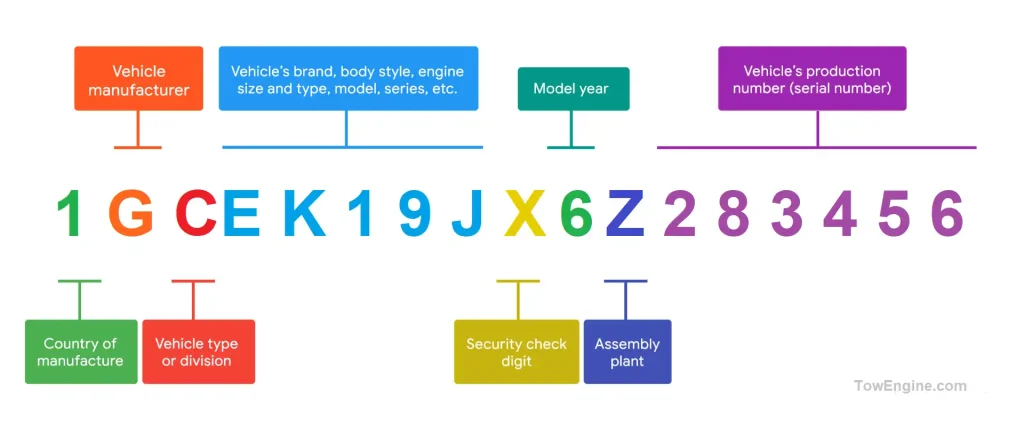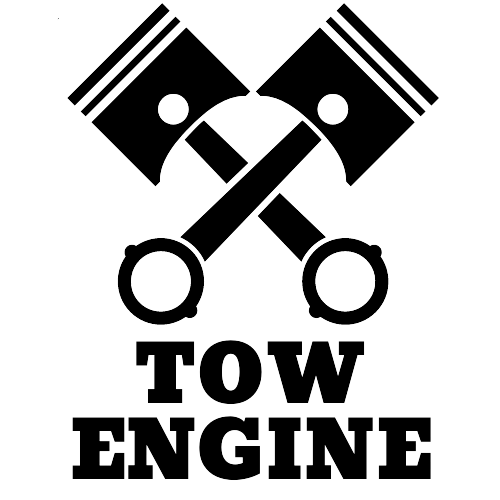Vehicle Specs by VIN for FREE (VIN Decoder & Free Lookup)
As a vehicle owner or potential buyer, it’s important to have accurate information about your vehicle or the vehicle you’re considering purchasing.
One way to obtain this information is through the Vehicle Identification Number (VIN). The VIN is a unique 17-character code assigned to every vehicle, which contains information about the manufacturer, model, year, and more.
With a VIN decoder, you can obtain detailed information about a vehicle’s specifications and history, allowing you to make informed decisions.
Vehicle Specs by VIN Decoder – Free VIN Lookup!

The VIN entered is invalid. Please check and try again.
In this article, we’ll explore how to find your vehicle’s VIN, how a VIN decoder works, the benefits of using a VIN decoder, and how to obtain vehicle specs by VIN for free for all makes and models.
What is a VIN?
As mentioned, a VIN is a 17-character code that serves as a unique identifier for each vehicle. The code includes information about the manufacturer, model, year, and production plant.
The VIN is divided into three sections: WMI (World Manufacturer Identifier), VDS (Vehicle Descriptor Section), and VIS (Vehicle Identifier Section).
- WMI (World Manufacturer Identifier): The first three characters of the VIN represent the WMI, which identifies the manufacturer of the vehicle and country.
- VDS (Vehicle Descriptor Section): The next six characters represent the VDS, which provides information about the vehicle’s features and specifications such as series, body style, and engine type.
- VIS (Vehicle Identifier Section): The final eight characters represent the VIS, which is a unique serial number assigned to each vehicle that includes the model year, assembly plant, and sequential number.
For example, a 2011 Ford Fiesta VIN might look like this: 3FADP4AJ7BM144214.
Once you have decoded your vehicle’s VIN, you will be able to access a wide range of information about your car, truck, or SUV.
Additionally, you can also find information about the vehicle’s specifications, such as the weight, dimensions, towing capacity, payload capacity, GCWR, GVWR, curb weight, and fuel efficiency ratings.
Understanding the Structure of the VIN
Before we dive into decoding the VIN, let’s first understand its structure. A standard VIN consists of 17 characters, which are a combination of letters and numbers. Each character represents specific information about the vehicle. Here’s how the VIN is structured:

Here’s an example of a VIN and how to decode it:
VIN: 1GCEK19JX6Z283456
- 1st digit (WMI): “1” represents the United States as the country of manufacture.
- 2nd digit (WMI): “G” represents General Motors as the manufacturer.
- 3rd digit (WMI): “C” represents a truck as the vehicle type or division.
- 4th-8th digits (VDS): “EK19J” represents the brand (Chevrolet), body style (Extended Cab Pickup), engine size and type (5.3L V8), model (Silverado), and series (1500).
- 9th digit (Check Digit): “X” is used to verify the validity of the VIN.
- 10th digit (Model Year): “6” represents the year 2006.
- 11th digit (Assembly Plant): “Z” represents the Fort Wayne Assembly plant in Indiana.
- 12th-17th digits (VIS): “283456” represents the vehicle’s production number (serial number).
By decoding this VIN, we can determine that the vehicle is a 2006 Chevrolet Silverado 1500 Extended Cab Pickup with a 5.3L V8 engine, manufactured at the Fort Wayne Assembly plant in Indiana.
Now that we know the structure of the VIN, let’s decode it step by step.
How to Decode VIN?
Here’re the simple steps and tables to decode your vehicle’s VIN:
Step 1: Country of Manufacture (WMI)
The first digit of the VIN represents the country where the vehicle was manufactured. For example, if the first digit is “1,” the vehicle was manufactured in the United States. If it’s “J,” the vehicle was manufactured in Japan. You can find a complete list of WMI codes in 3rd step.
Country of Origin Character Codes – World Manufacturer Identifier (WMI)
| WMI | Region | Notes |
|---|---|---|
| A-H | Africa | AA-AH = South Africa |
| J-R | Asia | >J = Japan KL-KR = South Korea L = China MF-MK = Indonesia MA-ME = India PA-PE = Philippines ML-MR = Thailand PL-PR = Malaysia MS = Myanmar RF-RG = Taiwan |
| S-Z | Europe | SA-SM = United Kingdom TW = Portugal TA-TH = Switzerland TJ-TP = Czech Republic TR-TV = Hungary VF-VR = France VS-VW = Spain SU-SZ = Poland XS-XW = USSR XL-XM = The Netherlands YF-YK = Finland YA-YE = Belgium YS-YW = Sweden ZA-ZR = Italy VX-V2 = Yugoslavia SN-ST, W = Germany X3-X0 = Russia |
| 1-5 | North America | 1, 4, 5 = United States 2 = Canada 3 = Mexico |
| 6-7 | Oceania | 6A-6W = Australia 7A-7E = New Zealand |
| 8-0 | South America | 8A-8E = Argentina 8F-8J = Chile 8X-82 = Venezuela 9A-9E, 93-99 = Brazil 9F-9J = Colombia |
Step 2: Vehicle Manufacturer (WMI)
The second digit of the VIN represents the manufacturer of the vehicle. For example, “G” represents General Motors, “F” represents Ford, and “T” represents Toyota.
Step 3: Vehicle Type or Division (WMI)
The third digit of the VIN represents the type of vehicle or division. For example, “1” represents a passenger car, “2” represents a multipurpose passenger vehicle, and “3” represents a truck.
Step 4: Brand, Body Style, Engine Size and Type, Model, Series, etc. (VDS)
The fourth through eighth digits of the VIN provides information about the vehicle’s brand, body style, engine size and type, model, series, etc.
This section is unique to each manufacturer and can be quite complex. You may need to consult a decoding chart specific to your vehicle’s make and model to understand this section fully.
Step 5: Security Check Digit
The ninth digit of the VIN is called the Check Digit. It’s used to verify the validity of the VIN by performing a mathematical calculation based on the other digits in the VIN.
Step 6: Model Year
The tenth digit of the VIN represents the Model Year of the vehicle. For example, “B” represents 1981, “C” represents 1982, and so on as provided in the following table.
| Code | Year | Code | Year | Code | Year | Code | Year |
|---|---|---|---|---|---|---|---|
| A | 1980 | L | 1990 | Y | 2000 | A | 2010 |
| B | 1981 | M | 1991 | 1 | 2001 | B | 2011 |
| C | 1982 | N | 1992 | 2 | 2002 | C | 2012 |
| D | 1983 | P | 1993 | 3 | 2003 | D | 2013 |
| E | 1984 | R | 1994 | 4 | 2004 | E | 2014 |
| F | 1985 | S | 1995 | 5 | 2005 | F | 2015 |
| G | 1986 | T | 1996 | 6 | 2006 | G | 2016 |
| H | 1987 | V | 1997 | 7 | 2007 | H | 2017 |
| J | 1988 | W | 1998 | 8 | 2008 | J | 2018 |
| K | 1989 | X | 1999 | 9 | 2009 | K | 2019 |
Step 7: Assembly Plant
The eleventh digit of the VIN indicates the assembly plant where the vehicle was manufactured. Each manufacturer has multiple assembly plants, and you can find a list of these codes online.
Step 8: Vehicle Production No. (VIS)
The last six digits of the VIN represent the Vehicle Identifier Section (VIS), which is the serial number assigned to the vehicle during production. This number is unique to each vehicle and is used for tracking purposes.
Vehicle Specs by VIN Decoder for All Makes and Models
If you own any of the numerous vehicle makes and models out there, finding the specs for your particular vehicle by VIN is a breeze.
Official manufacturer websites are an excellent resource for obtaining vehicle specs by VIN for free. The process for finding this information varies slightly depending on the manufacturer’s website.
These vehicles may include the following popular makes (a few of the many makes):
| Acura | Dacia | Holden | Lincoln | Peugeot | Skoda |
| BMW | Daewoo | Honda | Lotus | Piaggio | Smart |
| Alpina | Daf | Hummer | Mahindra | Plymouth | Subaru |
| Am General | Daihatsu | Hyundai | Maruti | Pontiac | Suzuki |
| Aston Martin | Daimler | Infiniti | Maserati | Porsche | Tata |
| Audi | Datsun | Isuzu | Mazda | Puch | Tesla |
| Bentley | Delorean | Iveco | Mclaren | Ram | Toyota |
| Bmw | Dodge | Jaguar | Mercedes Benz | Renault | Triumph |
| Buick | Eagle | Jeep | Mercury | Rolls Royce | Vauxhall |
| Cadillac | Ferrari | Kia | Mg | Rover | Volkswagen |
| Caterham | Fiat | Ktm | Mini | Saab | Volvo |
| Chevrolet | Ford | Lamborghini | Mitsubishi | Saleen | |
| Chevy | Geo | Lancia | Nissan | Saturn | |
| Chrysler | BMW | Land Rover | Oldsmobile | Scion | |
| Citroen | Great Wall | Lexus | Opel | Seat |
Where to Find the VIN?
The location of the VIN can vary depending on the make and model of your vehicle. Here are some common places to look:
1. Dashboard
The most common place to find the VIN is on the dashboard, near the windshield on the driver’s side. You should be able to see it by standing outside the car and looking through the windshield.
2. Driver’s Side Door Jamb
Another common location for the VIN is on the driver’s side door jamb. Open the door and look for a sticker with the VIN printed on it.
3. Engine Block
On some vehicles, the VIN may be stamped directly onto the engine block. This can be a bit trickier to locate, but if you pop the hood and look around the engine, you may be able to spot it.
4. Registration or Title
If you don’t have access to the vehicle itself, you can also find the VIN on the registration or title documents. These are usually kept in the glove compartment or with the owner’s other important papers.
Additionally, some online resources may allow you to search for your vehicle by make and model if you do not have the VIN readily available.
Common Vehicle Specs by VIN Decoder
When it comes to decoding the VIN of a vehicle, it can provide a wealth of information about the specific make and model. From the type of engine to the exterior and interior color, the VIN decoder can help determine the essential features of a vehicle.
In this regard, knowing the common vehicle specs that can be found using the VIN decoder can be highly beneficial. It allows you to gain an understanding of the vital specifications of a car, truck, or SUV before making a purchase.
Some of the most common specs that can be identified through VIN decoding include (may vary depending on the vehicle’s database):
- Year, make, and model
- Country of manufacture
- Trim level
- Body style
- Engine type and size
- Tank size
- Mileage
- Car warranty
- Turning diameter
- Electronic parking aid
- Anti-theft system
- Anti-brake system
- Front/rear brake type
- Transmission type
- Drive Type (2WD, 4WD, AWD)
- Steering type
- Suspension type
- Spring type
- Electronic brake assistance
- Vehicle stability control
- Heated steering wheel
- Climate controls
- Front/rear track size
- Airbag availability
- Overall height/width/length
- Tire type and size
- All headroom/legroom/shoulder room dimensions
- Loading capacity
- Cargo volume
- Air conditioning
- Navigation aid
- Remote ignition
- Tire pressure monitor
- Fuel type
- Vehicle weight
- GCWR
- GVWR
- Curb weight
- Payload capacity
- Towing capacity
- Wheelbase
- Production plant location
- Production year
- Manufacturer’s suggested retail price (MSRP)
- Invoice price
- Standard features
- Optional features
- Safety ratings
- Warranty information
- Vehicle history (accidents, theft, salvage title)
- Recall information
- Service records
Benefits of Knowing Your Vehicle’s Specs
Knowing a vehicle’s specs can be useful in many ways, from making an informed decision when purchasing a car to ensuring it is well-maintained and repaired.
Here are some examples of how vehicle specs can impact car buying, maintenance, and repair:
1. Car Buying
When buying a car, knowing its specs can help you make an informed decision. You can use the information to compare different models and make sure that the car you’re interested in has the features and specifications you’re looking for.
For example, if you’re looking for a car with good fuel economy, you can compare the fuel efficiency of different models to find the one that suits your needs.
2. Maintenance
Regular maintenance is essential for keeping your car running smoothly and preventing breakdowns. Knowing the specs of your vehicle can help you ensure that it is maintained properly.
For example, you can use the information to check the recommended oil type and capacity, tire size, and other important details.
3. Repair
If your car needs repairs, knowing its specs can help you ensure that the right parts are used. Using the wrong parts can cause problems and even damage your car. Knowing the correct specs can also help you troubleshoot problems and diagnose issues.
FAQs
What kind of information can be found using a VIN decoder?
A VIN decoder can provide a range of information about a vehicle, including the make and model, engine type and size, transmission type, fuel type, drive type, body style, production year, and manufacturing location.
Can I get vehicle specs by VIN for free?
Yes, there are several websites that offer free VIN decoding services. Simply enter the VIN number and the website will generate a report with information about the vehicle.
Can I find information about a vehicle’s history using a VIN decoder?
Yes, some VIN decoding services can provide information about a vehicle’s history, including whether it has been in accidents if it has a salvage title, and if it has been stolen.
Is it safe to provide my VIN number to a VIN decoder website?
Yes, it is generally safe to provide your VIN number to a reputable VIN decoding website. However, it is important to be cautious of scams or fraudulent websites that may misuse your personal information.
Are VIN decoders accurate?
In general, VIN decoders can provide accurate information about a vehicle. However, it is important to note that some information may be incomplete or inaccurate if it has not been properly recorded or if the VIN has been tampered with.
Conclusion
In conclusion, obtaining vehicle specifications is crucial for both vehicle owners and buyers to make informed decisions. The Vehicle Identification Number (VIN) is a unique 17-character code assigned to every vehicle, which contains information about the manufacturer, model, year, and more.
With a VIN decoder, you can access a wide range of information about a vehicle, including details such as the make, model, year, engine type, and even information about the factory where the vehicle was produced.
You can obtain vehicle specs by VIN for free for all makes and models by visiting official manufacturer websites, which offer free VIN decoders. Therefore, before making any vehicle-related decisions, it’s crucial to obtain accurate and reliable information through a VIN decoder.
Explore Capacities by Vehicle Make

